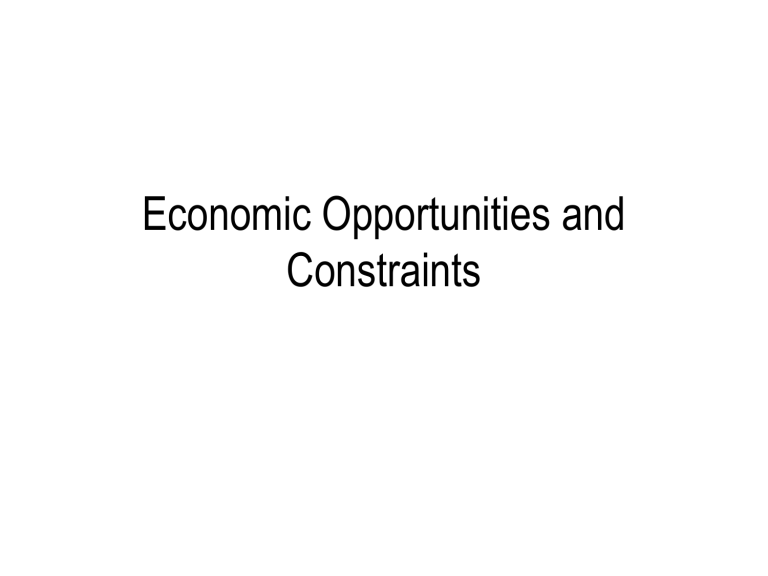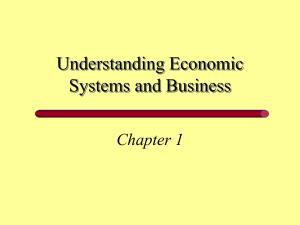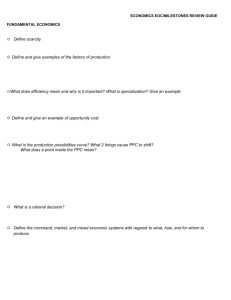Economic Opportunities and Constraints

Economic Opportunities and
Constraints
Content
• Market and competition:
– Types of market
– Capacity utilisation
– Fair and unfair competition
• Macro-economic issues:
– Business cycle
– Interest rates
– Exchange rates
– Inflation
– Unemployment
• Economic growth
• International competitiveness
• EU
The Market And Competition
• A market is a place where buyers and sellers meet to exchange goods and services
• Markets have a number of influences on businesses including:
– Market size
– Degree of competition within the market
– Type of market
Types of Market
• Markets can be categorised by the degree of competition and the number of firms
1. Perfect competition – this is a market with lots of small firms who produce similar products at similar prices
• No barriers to entry / exit
• Potential profits are low
Types of Market - Oligopoly
2. Few firms in the market who are interdependent in their actions
– Firms consider competitors reactions when changing prices / introducing new products
– There is a high degree of competition
– Businesses try and avoid price competition preferring non price competition
– Can be many take-overs
– Collusion may occur leading to cartels being formed
Types of Market - Monopoly
3. Monopoly – a single producer in the market
– One producer is able to charge relatively high prices
– New products are rarely introduced
– Resources are not used efficiently
– UK based monopolies are open to competition from overseas rivals
Capacity Utilisation
• The extent to which a firm uses the productive capacity available to it
• Markets can experience shortages of capacity meaning consumer needs are not met leading to:
– An increase in market price for products
– New producers being attracted to the market
– Consumers purchasing products overseas
• This is common where tastes and fashions change quickly or if there is a time lag between increases in demand and the firms ability to produce products
Fair and Unfair Competition
• UK markets are regulated to ensure free and fair competition
• Unfair competition includes cartels
• UK government and EU deem unfair competition as illegal
Business Cycle Stages
GDP
• Gross Domestic Product or GDP measures the value of a nation’s output over a period of time
• A nation’s business cycle will display regular fluctuations in economic activity (levels of spending, production and employment) and GDP
1. Recovery / Upswing
• The economy is recovering from a slump and production and employment is beginning to rise
• Customers are feeling more secure in their employment and are spending more (CONSUMER CONFIDENCE)
• Firms begin to invest more in FIXED ASSETS and increase their capacity
• Increased capacity involves more workers being employed
2. Boom
• Follows the recovery stage
• In this stage production levels are high so employment is also high
• Expenditure from businesses, consumers and the
Govt.increase as confidence grows
• The economy approaches maximum capacity and shortages / bottlenecks occur as raw materials run low
• Skilled workers become scarce and businesses try to attract workers with higher pay
• High wages and scarcity of resources lead to INFLATION
3. Recession
• The UK Government increases interest rates to curb inflation
• Rising prices of labour and materials mean that businesses costs of production rise significantly and eat into business profits
• Increases in interest rates prevent firms from borrowing and investing money
• Production begins to fall so workers laid off
4. Slump
• Often follows a recession
• Production is low and unemployment is high
• Demand is low
• Governments begin to take action by increasing their own spending to try to create jobs or lowering interest rates to boost demand
Interest rates
• Bank of England is responsible for setting interest rates
• Interest rates – price paid for borrowed money
• Consumer spending depends of interest rates as:
– When interest rates are high consumers are more likely to save
– Increasing in interest rates make borrowing more expensive reducing consumers disposable income
– Increasing interest rates increase mortgage payments
– Pensions and investments are dependent on interest rates
Interest Rates and Businesses
• Consequences of an increase in interest rates:
– Business overheads often increase
– Business may try to decrease borrowing
– Businesses try and save more
– Investment decisions are postponed
– Businesses try and reduce stock levels
• Some types of business are more effected e.g. those producing luxury items, those with high credit sales and those with high levels of overseas trade
• Businesses have a tendency to have a long term view on interest rates
What is an Exchange Rate?
• The value of a nation’s currency in terms of another currency
• i.e. £1=$2
• An exchange rate is set by demand and supply of a currency
Exchange Rates
• Exchange rates create uncertainty because:
– If a deal is agreed in foreign currency firms may receive more or less than expected due to changes in exchange rates
– Changes to exchange rates can affect prices and sales overseas
– Competitors can respond in unexpected ways to exchange rate changes
Interest and Exchange Rates
• Changes in the UK’s interest rates will lead to changes in the exchange value of the pound.
• If interest rates rise the value of the pound will rise so the pound will now buy more US dollars, Japanese Yen, Euros etc.
• If interest rates fall the value of the pound will fall so the pound will now buy less US dollars, Japanese Yen, Euros etc
Interest and Exchange Rates
• If interest rates are higher than rates in other countries the
UK will become more of an investment opportunity.
• Investors will exchange their currency into sterling to invest it in UK banks to earn high rates of interest on their savings.
• This will increase the DEMAND for Sterling which will appreciate in value
Interest and Exchange Rates
• If interest rates are lower than rates in other countries the
UK will become less of an investment opportunity.
• Investors will exchange their currency from sterling to invest it in Foreign banks.
• They will withdraw £ in the UK to buy foreign currency.
• This means an increased supply of sterling will be available in the world’s currency market causing the £ to depreciate
Inflation
• Inflation- A persistent increase in the level of consumer prices or a persistent decline in the purchasing power of money caused by an increase in available currency and credit beyond the proportion of available goods and services.
• Over the long term, inflation erodes the purchasing power of your income and wealth. That means that even as you save and invest, your accumulated wealth buys less and less.
How to measure inflation
• Every month the Government surveys prices and generates the current consumer price index (CPI)
• This allows you to compare current figures with past figures
The causes of inflation
• Inflation results when the macro economy has too much demand for available production.
1. Demand-Pull Inflation: This inflation occurs when the government / consumers / business try to purchase more output than the economy is capable of producing.
2. Cost-Push Inflation: Cost-push inflation is inflation due to decreases in supply, primarily due to increases in production cost
Inflation and Businesses
• Inflation may lead to a decrease in sales for businesses
• When there is high inflation it is hard for business to remain competitive especially with overseas firms
Inflation and Governmental Policy
• Governments try and control inflation using the following tools:
– An increase in interest rates
– Legislation reducing trade union power
– Reduced expectations of inflation allowing businesses more confidence when setting prices
Inflation
• In recent years inflation has been low, this means:
– Cost are easier to control
– Pricing strategies are easier to establish
– If UK inflation is lower than other countries gives UK firms a competitive advantage
– Sales forecasts will be more accurate
Unemployment
• There are a number of types of unemployment:
– Structural unemployment
– Cyclical unemployment
– Frictional unemployment
• Structural unemployment occurs when the economy changes and industries die out
• Training is needed to give the unemployed workers new skills
Unemployment
• Cyclical unemployment is caused by the business cycle
• Frictional unemployment is caused when people are temporarily out of work as they are moving jobs
Unemployment and Businesses
• Increasing levels of unemployment can cause problems for firms
• Cyclical unemployment can lead to a decrease in sales meaning businesses need to look for new markets
• Structural unemployment can affect businesses in the local area
Falling Unemployment
• Businesses can also incur problems due to falls in the level of unemployment as there may be skills and labour shortages
• If this is the case businesses can:
– Switch to capital intensive manufacturing systems
– Relocate overseas to exploit cheaper and more plentiful labour
– Invest in training schemes to develop employees skills
Economic Growth
• This is an increase in the value of goods and services produced by the economy as a whole
• Long term most countries experience economic growth
• In the shorter term countries can experience slumps
/ decline in the size of their economy
Advantages and Disadvantages of
Economic growth
Advantages
• It increases levels of taxation which the government can spend on public services
• Increases opportunities for all businesses / individuals
• Businesses experience higher sales and profits
Disadvantages
• Regional disparities
• Can lead to resource shortages especially for labour
• Increases pressure on individuals and businesses
Economic Growth
• Growth can be spurred on in the short term by decreases in interest rates and taxes, or by increasing Government spending
• These measures create fluctuations in GDP
• For the longer term the Government needs to increase employment (full employment), increase capacity, improving education and skills and promoting competition in markets
International Competitiveness
• With the growth of free trade businesses now are having to compete internationally
• This may be in order to increase profits and market share, or simply to wider their customer base to survive
• In order to be COMPETITIVE businesses must keep price affordable but keep the quality and features
Globalisation & Growth
• Many businesses have welcomed the concept of globalisation as a chance to attract a wider audience
• Other businesses have failed in markets of increased competition
EU
• The EU has 31 member states and over 450 million people
• The EU offers more consumers and therefore sales to UK based firms
• By locating in cheaper countries e.g. Eastern
Europe businesses are able to reduce costs
• Can also lead to increased competition
Institutions of the EU
• European commission – policy and legislation
• Council of ministers – unions decision making body
• European parliament
• European court of justice
• European central bank
The Euro
• In January 1999 the Euro was introduced into 12 countries
• By January 2002 Euro notes and coins were available
• The Euro influences markets by:
– Having cheaper transaction costs
– Stable exchange rates
– Transparent price differences
Summary
• Businesses are influenced by the market they operate in
• Perfect competition exists where there are many firms all producing similar products charging similar prices
• Oligopolies exist where there are few firms who have a high degree of interdependence
• Monopolies exist where there is one firm in the market
• Capacity utilisation refers to how well businesses are using the productive capacity available to them, markets may experience shortages in capacity
• The UK government tries to ensure fair competition within markets
• The business cycle shows the rate of economic growth over time and includes recession and boom periods
• Interest rates are the cost of borrowing money
• Exchange rates value one currency in terms of another
• Inflation is the rise in the general level of prices
• Unemployment measures the total amount of people out of work and can include structural ,cyclical and frictional types
• Economic growth measures the rate at which the economy is growing in size
• As markets are becoming increasingly global it is important for firms to compete on an international scale
• The EU is a collection of 31 countries which have no trade barriers creating opportunities and threats for
UK businesses







